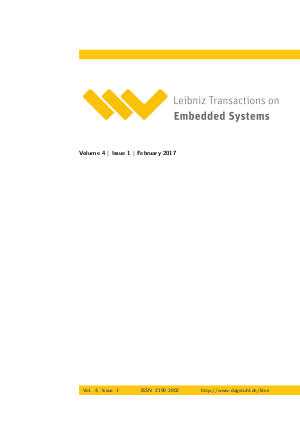Leibniz Transactions on Embedded Systems, Volume 4, Issue 1
LITES, Volume 4, Issue 1
-
Part of:
Volume:
LITES, Volume 4
Journal: Leibniz Transactions on Embedded Systems (LITES)

Publication Details
- published at: 2017-02-28
- Publisher: Schloss Dagstuhl – Leibniz-Zentrum für Informatik
- DBLP: db/journals/lites/lites4
Access Numbers
- Detailed Access Statistics available here
-
Total Accesses (updated on a weekly basis)
0Documents
Documents
LITES, Volume 4, Issue 1
Abstract
Cite as
LITES, Volume 4, Issue 1, Schloss Dagstuhl – Leibniz-Zentrum für Informatik (2017)
Copy BibTex To Clipboard
@Article{LITES-v004-i001,
title = {{LITES, Volume 4, Issue 1}},
journal = {Leibniz Transactions on Embedded Systems},
ISSN = {2199-2002},
year = {2017},
volume = {4},
number = {1},
publisher = {Schloss Dagstuhl -- Leibniz-Zentrum f{\"u}r Informatik},
address = {Dagstuhl, Germany},
URL = {https://drops.dagstuhl.de/entities/document/10.4230/LITES-v004-i001},
doi = {10.4230/LITES-v004-i001},
annote = {Keywords: LITES, Volume 4, Issue 1}
}
A Note on the Period Enforcer Algorithm for Self-Suspending Tasks
Abstract
Cite as
Jian-Jia Chen and Björn B. Brandenburg. A Note on the Period Enforcer Algorithm for Self-Suspending Tasks. In LITES, Volume 4, Issue 1 (2017). Leibniz Transactions on Embedded Systems, Volume 4, Issue 1, pp. 01:1-01:22, Schloss Dagstuhl – Leibniz-Zentrum für Informatik (2017)
Copy BibTex To Clipboard
@Article{chen_et_al:LITES-v004-i001-a001,
author = {Chen, Jian-Jia and Brandenburg, Bj\"{o}rn B.},
title = {{A Note on the Period Enforcer Algorithm for Self-Suspending Tasks}},
journal = {Leibniz Transactions on Embedded Systems},
pages = {01:1--01:22},
ISSN = {2199-2002},
year = {2017},
volume = {4},
number = {1},
publisher = {Schloss Dagstuhl -- Leibniz-Zentrum f{\"u}r Informatik},
address = {Dagstuhl, Germany},
URL = {https://drops.dagstuhl.de/entities/document/10.4230/LITES-v004-i001-a001},
URN = {urn:nbn:de:0030-drops-192625},
doi = {10.4230/LITES-v004-i001-a001},
annote = {Keywords: Period Enforcer, Deferred Execution, Self-suspension, Blocking}
}
Utility-Based Scheduling of (m,k)-firm Real-Time Tasks - New Empirical Results
Abstract
Cite as
Florian Kluge. Utility-Based Scheduling of (m,k)-firm Real-Time Tasks - New Empirical Results. In LITES, Volume 4, Issue 1 (2017). Leibniz Transactions on Embedded Systems, Volume 4, Issue 1, pp. 02:1-02:25, Schloss Dagstuhl – Leibniz-Zentrum für Informatik (2017)
Copy BibTex To Clipboard
@Article{kluge:LITES-v004-i001-a002,
author = {Kluge, Florian},
title = {{Utility-Based Scheduling of (m,k)-firm Real-Time Tasks - New Empirical Results}},
journal = {Leibniz Transactions on Embedded Systems},
pages = {02:1--02:25},
ISSN = {2199-2002},
year = {2017},
volume = {4},
number = {1},
publisher = {Schloss Dagstuhl -- Leibniz-Zentrum f{\"u}r Informatik},
address = {Dagstuhl, Germany},
URL = {https://drops.dagstuhl.de/entities/document/10.4230/LITES-v004-i001-a002},
URN = {urn:nbn:de:0030-drops-192635},
doi = {10.4230/LITES-v004-i001-a002},
annote = {Keywords: Real-time Scheduling, (m, k)-Firm Real-Time Tasks}
}
Quantitative Analysis of Consistency in NoSQL Key-Value Stores
Abstract
Cite as
Si Liu, Jatin Ganhotra, Muntasir Raihan Rahman, Son Nguyen, Indranil Gupta, and José Meseguer. Quantitative Analysis of Consistency in NoSQL Key-Value Stores. In LITES, Volume 4, Issue 1 (2017). Leibniz Transactions on Embedded Systems, Volume 4, Issue 1, pp. 03:1-03:26, Schloss Dagstuhl – Leibniz-Zentrum für Informatik (2017)
Copy BibTex To Clipboard
@Article{liu_et_al:LITES-v004-i001-a003,
author = {Liu, Si and Ganhotra, Jatin and Rahman, Muntasir Raihan and Nguyen, Son and Gupta, Indranil and Meseguer, Jos\'{e}},
title = {{Quantitative Analysis of Consistency in NoSQL Key-Value Stores}},
journal = {Leibniz Transactions on Embedded Systems},
pages = {03:1--03:26},
ISSN = {2199-2002},
year = {2017},
volume = {4},
number = {1},
publisher = {Schloss Dagstuhl -- Leibniz-Zentrum f{\"u}r Informatik},
address = {Dagstuhl, Germany},
URL = {https://drops.dagstuhl.de/entities/document/10.4230/LITES-v004-i001-a003},
URN = {urn:nbn:de:0030-drops-192649},
doi = {10.4230/LITES-v004-i001-a003},
annote = {Keywords: NoSQL Key-value Store, Consistency, Statistical Model Checking, Rewriting Logic, Maude}
}
How Is Your Satellite Doing? Battery Kinetics with Recharging and Uncertainty
Abstract
Cite as
Holger Hermanns, Jan Krčál, and Gilles Nies. How Is Your Satellite Doing? Battery Kinetics with Recharging and Uncertainty. In LITES, Volume 4, Issue 1 (2017). Leibniz Transactions on Embedded Systems, Volume 4, Issue 1, pp. 04:1-04:28, Schloss Dagstuhl – Leibniz-Zentrum für Informatik (2017)
Copy BibTex To Clipboard
@Article{hermanns_et_al:LITES-v004-i001-a004,
author = {Hermanns, Holger and Kr\v{c}\'{a}l, Jan and Nies, Gilles},
title = {{How Is Your Satellite Doing? Battery Kinetics with Recharging and Uncertainty}},
journal = {Leibniz Transactions on Embedded Systems},
pages = {04:1--04:28},
ISSN = {2199-2002},
year = {2017},
volume = {4},
number = {1},
publisher = {Schloss Dagstuhl -- Leibniz-Zentrum f{\"u}r Informatik},
address = {Dagstuhl, Germany},
URL = {https://drops.dagstuhl.de/entities/document/10.4230/LITES-v004-i001-a004},
URN = {urn:nbn:de:0030-drops-192655},
doi = {10.4230/LITES-v004-i001-a004},
annote = {Keywords: Battery Power, Depletion Risk, Bounded Charging and Discharging, Stochastic Load, Distribution Bounds}
}
Characterizing Data Dependence Constraints for Dynamic Reliability Using n-Queens Attack Domains
Abstract
Cite as
Eric W. D. Rozier, Kristin Y. Rozier, and Ulya Bayram. Characterizing Data Dependence Constraints for Dynamic Reliability Using n-Queens Attack Domains. In LITES, Volume 4, Issue 1 (2017). Leibniz Transactions on Embedded Systems, Volume 4, Issue 1, pp. 05:1-05:26, Schloss Dagstuhl – Leibniz-Zentrum für Informatik (2017)
Copy BibTex To Clipboard
@Article{rozier_et_al:LITES-v004-i001-a005,
author = {Rozier, Eric W. D. and Rozier, Kristin Y. and Bayram, Ulya},
title = {{Characterizing Data Dependence Constraints for Dynamic Reliability Using n-Queens Attack Domains}},
journal = {Leibniz Transactions on Embedded Systems},
pages = {05:1--05:26},
ISSN = {2199-2002},
year = {2017},
volume = {4},
number = {1},
publisher = {Schloss Dagstuhl -- Leibniz-Zentrum f{\"u}r Informatik},
address = {Dagstuhl, Germany},
URL = {https://drops.dagstuhl.de/entities/document/10.4230/LITES-v004-i001-a005},
URN = {urn:nbn:de:0030-drops-192667},
doi = {10.4230/LITES-v004-i001-a005},
annote = {Keywords: SMT, Data dependence, n-queens}
}